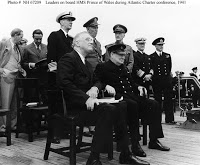 |
| FDR and Churchill – The Atlantic Charter |
Toomas Trei
Activist Post
With an ineffectual League of Nations and Bolshevik USSR and Nazi Germany assisting each other in military buildup, the small independent nations in the “cordon sanitaire” between Germany and Soviet Union were vulnerable to the expansionist aspirations of their much more powerful and ideologically driven neighbours. Even though the Soviet Union was formally recognized by Roosevelt in 1933, and was subsequently allowed into the League of Nations in 1934, its small neighbours were well aware of the Bolshevik reign of terror upon its own people, and the threat that it posed to them.
On August 23, 1939, the Nazis and Soviets signed the Molotov-Ribbentrop Pact (MRP), dividing Europe into two defined spheres of influence. These two evil powers would subsequently divide Poland. On September 1, 1939, the Nazis attacked Poland to take their partition as agreed to in the MRP, and two days later, France and Great Britain declared war on Germany in support of their ally. When the Soviets invaded Poland on September 17, 1939 and took their MRP partition, neither France nor Britain ever declared war on the Soviet Union in support of their beleaguered ally.
(In 2017, Winston Churchill’s archives are to be released which should reveal whether prior to July 1939 there was an understanding in place between Churchill and Stalin.)
In the autumn of 1939, the Soviets forced agreements for military bases upon the Estonian, Latvian and Lithuanian governments. After Finland was attacked in Karelia on December 1, the USA issued a “moral embargo” on trade with the Soviets, and on December 14, the Soviet Union was expelled from the League of Nations.
Information about a secret agreement (Document S-32) between the Soviet Union, France and Britain made on October 15, 1939, allowed Finland to be occupied by the Soviets. This helps explain why Finland received no aid from the west in spite of being an innocent victim to naked Soviet aggression. (This secret S-32 document is part of the Churchill archive to be released in 2017.)[1] The Soviet-Finland Winter War hostilities ceased when a peace agreement was reached on March 13, 1940. Although Finland ceded Karelia to the Soviets along with naval bases and some other conditions, most importantly Finland retained its sovereignty.
Soviet aggression continued and in June 1940 the Baltic States were forcibly incorporated into the Soviet Union. Then the nationalistically based leaders of the Baltic countries were killed or deported, leaving the Soviet Communists firmly in charge. Thus began the first reign of terror on the local citizenry. At this same time, the Allies were tracking aggressive Nazi actions in Western Europe, and were seeing the fall of France.
Acting Secretary of State Sumner Welles’ declaration on July 23, 1940 refused to recognize ‘de jure’ the illegal Soviet occupation of the Baltic countries.; “… the devious processes whereunder the political independence and territorial integrity of the three small Baltic republics – Estonia, Latvia and Lithuania – were to be deliberately annihilated by one of their more powerful neighbours … The policy of this Government is universally known. The people of the United States are opposed to predatory activities …
They are likewise opposed to any form of intervention on the part of one state however powerful, in the domestic affairs of any other sovereign state, however weak … The United States will continue to stand by these principles…”[2]
FELLOW TRAVELLERS
In spite of the atrocities carried out by Stalin’s Soviet regime in Poland, Finland, and the Baltic Republics, the U.S. trade embargo against the Soviets was reversed by FDR in January 1941, even though the Soviets were still aligned with and supplied the Nazi war machine on the western front. FDR’s decision shows that his government continued to have a close relationship with the USSR, in spite of their being a Nazi Germany’s ally.
In June 1941, U.S. agents in Germany provided FDR with information on the Nazi Barbarossa plan to attack the Soviet Union, and this was passed along to Soviet Ambassador Oumansky in Washington.[3] When the Nazis did attack the Soviet Union on June 22, 1941, FDR wanted to send the Soviets immediate massive aid, disregarding the territorial aggressions and massacres by the Soviets. Two days after Hitler attacked the Soviets, FDR did release $39 million in frozen Soviet assets. A month later he sent his personal representative Harry Hopkins to visit Stalin in Moscow, upon which author Susan Butler commented, “Roosevelt’s eyes and ears – virtually his alter ego – carried the president’s first message to Stalin assuring him that the United States was coming to the aid of the beleaguered nation.”[4]
Within a month of the Nazi attack, FDR had a list of Soviet requirements, and when the speed of delivering the U.S aid did not meet his satisfaction, FDR sent a pointed memo to Liaison Officer Wayne Coy in the Office of Emergency Management on August 2, 1941 with a clear message; “please get out the list, and please with my full authourity use a heavy hand – act as a burr under the saddle and get things moving … Step on it!”[5]
By August 12, Wayne Coy was able to reply to Russian Ambassador Oumansky that a rubber plant and over 100 other manufacturing plants would be supplied to the Soviets.[6] In addition, guns, bombs, pursuit planes, bombers, anti aircraft guns, machine guns, motorized vehicles, ammunition, aluminum and wool were on the list of items to be released to the USSR.[7] Stalin never revealed the extent of the US aid to the Soviet people nor did he thank or pay the United States.
When U.S. Ambassador to the USSR Admiral Standley detailed the massive amount of US Lend-Lease aid to the Soviets at a Moscow press conference in March 1943, he was rebuked for speaking up.[8] Later Harry Hopkins even shipped to the Soviets sensitive “ultra-scarce uranium, heavy water and vast amounts of thin copper wire and numerous other important items.”[9]
FLUFF AND FACTS
In mid August 1941, Winston Churchill and Roosevelt met at sea off the Newfoundland coast at Argentia to discuss the principles for the post WWII peace settlement.
Their joint declaration, the Atlantic Charter, was released to the press from the White House on August 14 promising Wilsonian guarantees for all nations; “Their countries seek no aggrandizement territorial or other … they desire to see no territorial changes that do not accord with the freely expressed wishes of the people concerned … they respect the rights of all people to choose the form of government under which they will live”.[10]
Stalin also endorsed the principles of the Atlantic Charter in the January 1, 1942, declaration together with the other allies, so the Charter initially held out hope for a just post WWII peace for the peoples in the Soviet occupied territory of Central and Eastern Europe. However, by the end of 1945, this Atlantic Charter turned out to be inconsequential rhetoric, far from the Ten Commandments and Magna Carta to which FDR had originally compared the Charter’s principles.[11]
The implementation of the principles of the Atlantic Charter was not the post war outcome that the Council of Foreign Relations (CFR) leadership wanted as described in their 1941 recommendation document ‘National Sovereignty and the International Tasks For of the Post War World’; “From the international viewpoint, by the nineteenth century, sovereignty in its extreme form was, in fact, becoming an anachronism.” … the flames of nationalism fanned by the war as well as by the Wilsonian principle of ‘self determination’ … The Atlantic Charter itself holds out the promise that “sovereign rights” may be restored to those people who have forcibly been denied of them … it may not be possible to secure the fullest collaboration of all nations in the economic field … or to realize the “freedom from fear and want” … in short, how may this popular fetishism of sovereignty be sufficiently dissolved to facilitate the establishment of an international society…”[12]
Specifically, on October 26, 1940, the CFR had already identified the Baltic States of Estonia, Latvia and Lithuania as mere bargaining chips, while the Nazis and the Soviets were still allies: “The United States should consider the problem of eventual recognition of Russia’s claim to the Baltic area as a means to win Soviet support against the Nazis.”[13]
This CFR policy statement was a direct contradiction to the Wells declaration from just three months earlier, when the illegal Soviet occupation of Estonia, Latvia, and Lithuania was not formally recognized by the U.S.A. Carroll Quigley described the CFR’s ‘modus operandi’; “In fact this network, which we may identify as the Round Table Groups, has no aversion to cooperating with the Communists, or any other group, and frequently does so.”[14]
The CFR post WWII plans were concocted when the U.S. was not even in the war, its citizens having voted in the 1940 election for Roosevelt who ran on an isolationist platform. A catastrophic event would have to occur to allow FDR to change his mind.[15] The event that would be used to propel the United States into World War II turned out to be the Japanese ‘sneak’ attack on Pearl Harbor.
Author Robert Stinnett wrote that FDR had access to Japanese military and diplomatic reports from early 1940 to December 7, 1941.[16] In an attempt to provoke a Japanese attack on the United States, FDR deployed American warships within and adjacent to territorial waters of Japan, even though Pacific Fleet Commander Admiral Husband Kimmel warned that, “it was ill- advised and will result in war if we make this move.”[17]
Admiral Richardson, who opposed FDR’s strategy of putting his men and fleet in danger “in order to provoke what he called a Japanese mistake”[18], was replaced by officers who would go along with FDR’s provocation policy.
In early December of 1941, FDR’s administration intercepted communiqués that indicated an attack on Pearl Harbor was imminent. That information was not communicated to the Pacific Fleet in a timely manner, while on the eve of the attack FDR commented to his staff that “our affairs with Japan are in a very critical condition”[19], yet he undertook no action to inform navy commanders at Pearl Harbor. (The attack on Pearl Harbor was used in a similar manner as was the 1915 sinking of the Lusitania which helped to promote U.S. entry into WWI even though Americans in 1916 had also voted for Wilson on his promise to ‘stay out of the war’.)
After the massacre of 16,000 Polish officers in the Katyn forest was uncovered in 1943, Stalin, in an April 21, 1943 communiqué, lied directly to FDR about who was responsible for these killings; “Hitlerite authourities, after perpetrating an atrocious crime against the Polish officers, are now engaged in an investigation farce.”[20]
When Prime Minister Sikorski of the Polish Government in Exile requested a Red Cross examination of the Katyn massacre, Roosevelt, on April 26 sent the following cable to Stalin: “Sikorski … made a mistake in taking up the matter with the International Red Cross … I am inclined to think that Churchill will find ways and means of getting the Polish Government in London to act with more common sense in the future.”[21] This showed that FDR was not really looking for the truth, nor to help Poland.
On July 4, 1943, a British airplane taking off from Gibraltar crashed, killing Sikorski. This crime is still unsolved. Churchill’s personal 976-page abridgement of ‘The Second World War’ (Pimlico) makes no mention of Katyn nor Sikorski, even though fighting for Poland’s liberation was the reason Great Britain went to war!
FDR’s acquiescence to the Soviets at the expense of the American taxpayer reached unbelievable proportions in May 1944 when he allowed his “alter-ego” advisor and Lend-Lease administrator Harry Hopkins, Secretary of the Treasury Henry Morgenthau Jr. and Under-Secretary of the Treasury Harry Dexter White to provide the Soviets with “several planeloads of our money plates and special paper and special ink,” (the same money plates the US was using) for printing the military-mark currency that would be used for post war reconstruction in Germany.[22] All of these military-marks would eventually be redeemed by the U.S. Treasury. No controls were posed by the U.S. government on how the Soviets printed and used this military-money.
When the Soviets said that one of these ‘money’ planes had crashed in Siberia, another airplane loaded with similar supplies was quickly dispatched. From Major Jordan’s book, From Major Jordan’s Diaries [Chapter 12 How Russia Got U.S. Treasury Plates], when the program ended in 1946, over $2.5 billion of these marks were redeemed over the amount printed in the United States.
Notes:
[22]Dall, C..B., F.D.R. My Exploited Father-in-Law, Christian Crusade Publications, Tulsa , 1968, p 80
Part 1: The Global Bankers’ FDR: A Communist Fellow Traveller
Part 2: The Global Bankers’ FDR: US Federal Reserve
Part 3: The Global Bankers’ FDR: Post WWI
Toomas Trei was born in Sweden in 1950 to parents who escaped when the Communists occupied Estonia. His mother always said ‘don’t believe everything that is written about history’.
linkwithin_text=’Related Articles:’




Be the first to comment on "The Global Bankers’ FDR: Cats and Mice (Part 4 of 5)"